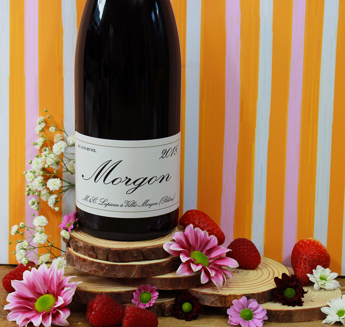Beautiful wine deserves beautiful food! Our favourite pairings with pink
Spring is round the corner, and with it the promise of warm days and balmy evenings. For some people that means one thing: it's time to drink pink!
But in the world of food and wine pairing, rosé is often left in the dust. Lying in the 'mid-ground' between white and red, many aren't too sure what to do with it when it comes to food matching. For many, it's seen as a less 'serious' option; something to enjoy in a sun-drenched beer garden rather than a proper accompaniment to a meal.
 Yet in fact, rosé is one of the most versatile options when it comes to food matching, and it's surprisingly simple to find a wine that will enhance most dishes.
Yet in fact, rosé is one of the most versatile options when it comes to food matching, and it's surprisingly simple to find a wine that will enhance most dishes.
Best of both: what makes rosé work with food?
Rosé combines some of the best elements of white and red wines, providing a unique spectrum of flavours and aromas that make it suitable for pairing with a variety of dishes.
Like white wines, many rosés have a light mouthfeel and refreshing acidity. Yet, through spending time on skins (however minimal that time may have been), rosés also benefit from additional levels of structure, body and tannin, making them hugely versatile when it comes to food pairing.
And what about chilling reds?
A similar balance can be achieved by cooling down red wines. While reds are typically served un-chilled, reducing their average temperature down to around 10-13°C brings fruity flavours and acidity into focus, unveiling qualities and complexity that you might not have even realised were there.
While not every bottle will benefit from chilling - a cold Cabernet Sauvignon, for example, isn't likely to taste of much other than regret-inducing-bitterness - light-bodied, fruit driven reds like Beaujolais, Pinot Noir and Grenache will find themselves hugely enhanced by a short burst in an ice bucket.
But what to match them with?
Of course, matching food to wine is always a hugely subjective affair, but there are some rules which can help you guide a bottle to its perfect dish.
We've picked a few of our favourite pinks, from pale provencal to chillable light reds, and explored some delicious dishes to accompany them.
Light and dry rosé
Examples: Ultimate Provence, Chateau Saint Roux Pigeonnier, Domaine Lafage Miraflors, Whispering Angel
 What to pair them with: Balance is key when dealing with delicate wines like these. Richer dishes are likely to overpower subtle aromas and flavours, leading the wine to taste 'watery' - or lacking in substance. Provencal tradition sees its regional wines drunk alongside fragrant, fresh and herbal dishes, with the light red fruit aromas complementing these delicate notes, without being overpowering. Light dishes like salads are also always a great choice - just make sure to avoid bitter greens like kale, where the flavours are too strong for the wine.
What to pair them with: Balance is key when dealing with delicate wines like these. Richer dishes are likely to overpower subtle aromas and flavours, leading the wine to taste 'watery' - or lacking in substance. Provencal tradition sees its regional wines drunk alongside fragrant, fresh and herbal dishes, with the light red fruit aromas complementing these delicate notes, without being overpowering. Light dishes like salads are also always a great choice - just make sure to avoid bitter greens like kale, where the flavours are too strong for the wine.
Medium-bodied, fruity rosé
Example: Charles Smith Band of Roses
 What to pair them with: Spice! While wines rich in tannin or acid enhance spicier flavours and overwhelm the palate, New World rosés in particular offer up a riper, sweeter profile, that works to balance spice perfectly. Alternatively, seafood is a great match for more medium-bodied rosé. The fuller texture of the wine harmonises well with the brininess of seafood, as do any flavours of red berry and melon. These broaden out the saltier notes in food, creating a well-rounded pairing.
What to pair them with: Spice! While wines rich in tannin or acid enhance spicier flavours and overwhelm the palate, New World rosés in particular offer up a riper, sweeter profile, that works to balance spice perfectly. Alternatively, seafood is a great match for more medium-bodied rosé. The fuller texture of the wine harmonises well with the brininess of seafood, as do any flavours of red berry and melon. These broaden out the saltier notes in food, creating a well-rounded pairing.
Full-bodied, dark rosés and chilled reds
Examples: Prophets Rock Infusion, Morgon Lapierre, Garage Old Vine Pale
 What to pair them with: As soon as most people think of matching a wine with meat, their minds jump automatically to reds - but this is where fuller-bodied rosés and chillable reds can come into their own. Whether it's a darker rosé or a chilled red, any wine with ripe fruit and adequate structure will more than hold its own against meaty or barbecued flavours. Red fruit aromas and flavours will work to cut through any 'charred' notes, and can be a great option for al fresco dining or summer lunches.
What to pair them with: As soon as most people think of matching a wine with meat, their minds jump automatically to reds - but this is where fuller-bodied rosés and chillable reds can come into their own. Whether it's a darker rosé or a chilled red, any wine with ripe fruit and adequate structure will more than hold its own against meaty or barbecued flavours. Red fruit aromas and flavours will work to cut through any 'charred' notes, and can be a great option for al fresco dining or summer lunches.






